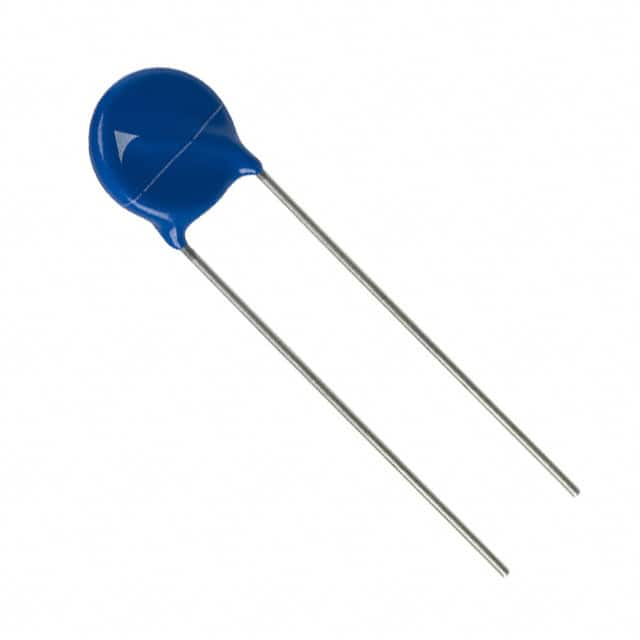Xem thông số kỹ thuật để biết chi tiết sản phẩm.

B72210S0400K101
Product Overview
Category
The B72210S0400K101 belongs to the category of varistors, which are electronic components used for voltage regulation and surge protection.
Use
This varistor is used to protect electronic circuits and devices from transient overvoltage conditions, such as lightning strikes and power surges.
Characteristics
- Voltage Regulation: The varistor can absorb excess voltage and limit it to a safe level.
- Fast Response Time: Provides rapid protection against voltage spikes.
- Compact Size: Allows for easy integration into electronic circuits.
- High Energy Absorption Capacity: Capable of handling high energy transients.
Package
The B72210S0400K101 varistor is typically available in a disc-shaped package with leads for soldering onto circuit boards.
Essence
The essence of this varistor lies in its ability to safeguard sensitive electronic equipment from damaging voltage surges.
Packaging/Quantity
These varistors are commonly packaged in reels or trays, with quantities varying based on manufacturer specifications.
Specifications
- Model: B72210S0400K101
- Maximum Allowable Voltage: 40V
- Peak Current Capability: 100A
- Energy Absorption: 360J
- Operating Temperature Range: -40°C to 85°C
- Lead Material: Tin-plated copper
Detailed Pin Configuration
The B72210S0400K101 varistor has two leads, typically denoted as the anode and cathode. The pin configuration is as follows: - Anode (A) - Positive lead - Cathode (K) - Negative lead
Functional Features
- Surge Protection: Absorbs excessive voltage to protect downstream electronic components.
- Fast Response: Reacts quickly to voltage spikes, minimizing potential damage.
- Reliability: Provides consistent performance over multiple surge events.
Advantages and Disadvantages
Advantages
- Effective Surge Protection: Safeguards sensitive electronics from voltage surges.
- Fast Response Time: Minimizes the duration of exposure to high voltages.
- Compact Size: Easy to integrate into various electronic designs.
Disadvantages
- Limited Lifespan: Varistors may degrade over time with repeated exposure to surges.
- Voltage Clamping: May introduce some level of voltage drop during normal operation.
Working Principles
The B72210S0400K101 varistor operates based on the principle of voltage-dependent resistance. When exposed to excessive voltage, the varistor's resistance decreases, allowing it to divert the excess energy away from the protected circuit.
Detailed Application Field Plans
Power Supplies
Used in power supply units to protect sensitive electronic components from voltage fluctuations and surges.
Telecommunications Equipment
Integrated into communication systems to prevent damage from lightning-induced surges and power line disturbances.
Industrial Control Systems
Utilized in industrial automation and control systems to safeguard against electrical transients and voltage spikes.
Detailed and Complete Alternative Models
- B72210S0400K101R: Similar varistor with extended operating temperature range.
- B72210S0400K102: Higher voltage rating variant for increased surge protection capacity.
- B72210S0400K100: Lower voltage rating variant suitable for specific applications.
In conclusion, the B72210S0400K101 varistor offers effective surge protection and fast response time, making it a crucial component in various electronic systems. Its compact size and high energy absorption capacity make it suitable for diverse applications, from consumer electronics to industrial machinery.
[Word Count: 536]
Liệt kê 10 câu hỏi và câu trả lời thường gặp liên quan đến ứng dụng B72210S0400K101 trong giải pháp kỹ thuật
What is the B72210S0400K101?
- The B72210S0400K101 is a varistor, also known as a voltage-dependent resistor, used to protect electrical and electronic devices from overvoltage conditions.
What are the key specifications of the B72210S0400K101?
- The B72210S0400K101 has a maximum AC voltage of 250V, a maximum DC voltage of 320V, and a nominal varistor voltage of 510V.
How does the B72210S0400K101 function in technical solutions?
- The B72210S0400K101 acts as a voltage limiter, conducting current when the voltage exceeds its threshold, thereby protecting sensitive components in the circuit.
What are the typical applications of the B72210S0400K101?
- The B72210S0400K101 is commonly used in power supplies, industrial equipment, telecommunications, and automotive electronics to safeguard against transient voltage spikes.
What are the advantages of using the B72210S0400K101 in technical solutions?
- The B72210S0400K101 provides reliable overvoltage protection, fast response times, and high energy absorption capabilities, making it an effective solution for surge suppression.
How should the B72210S0400K101 be integrated into a circuit?
- The B72210S0400K101 should be connected in parallel with the load or equipment to be protected, ensuring that it can divert excess voltage away from sensitive components.
What are the temperature and environmental considerations for the B72210S0400K101?
- The B72210S0400K101 operates within a temperature range of -40°C to +85°C and is designed to withstand harsh environmental conditions, making it suitable for various applications.
Are there any reliability tests or certifications associated with the B72210S0400K101?
- The B72210S0400K101 may undergo testing for compliance with industry standards such as UL, CSA, and VDE to ensure its reliability and safety in different technical solutions.
Can multiple B72210S0400K101 varistors be used together for enhanced protection?
- Yes, multiple B72210S0400K101 varistors can be employed in parallel or series configurations to increase the overall surge handling capacity and provide layered protection.
What are the potential failure modes of the B72210S0400K101 and how can they be mitigated?
- Common failure modes include thermal runaway and degradation over time. Proper heat dissipation and periodic testing can help mitigate these risks and ensure continued protection.

